|
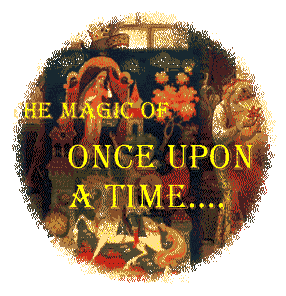
Narrative Logo - Click for Main Menu
Lecture VI: The Ancient Skies and the Origins of the World
This unit will take a
close look at one of the "tale types," the Origin of the World story.
"A Myth is all
about wonders." Aristotle
"Among the most basic questions raised by
human beings are those of origins. How did the human species arise? How was the earth
created? What about the sun? the moon? the stars? Why do we have night and day? Why do
people die? No human society lacks answers to such questions. While these answers vary
greatly in detail, they are, for primitive peoples as a whole, similar in their basic
form: people and the world exist because they were brought into being by a series of
creative acts.
Moreover, this creation is usually regarded as the work of supernatural beings or forces.
The accounts of the ways in which
these supernatural agents formed the earth and peopled it are known as origin myths."
from an essay on Origin Myths by Robert L. Carneiro
American Museum of Natural History
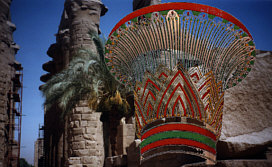
Caption: Columns at Luxor, Egypt
We have visited the ancient skies in
several stories already - the myths and legends of Egyptian antiquity, the stories of
American Indians, and the earliest tales from Sumeria. You have also finished
your
reading of Krupp, and have a good idea of how central the sky was to our ancestors.
Several important mythologists,
anthropologists, and cultural critics have undertaken the study of Origin Stories
- and
while their findings and theories overlap in several areas, their conclusions about what
these tales mean often differ surprisingly.

Caption: The eternal garden of the Nile -
banks of paradise
First, we want to look at the way that
Origin Tales fit in with what we already know. While the Origin story fits into the
Motif Index as type U - Nature of Life, it also may overlap into other tale types and use
several of the motifs - for example, many cultures have origin tales that involve animals
(Motif type B). The Chumash Indians of California believed that the Turtle was
largely responsible for the first material that made the land - and the wily Coyote figures
in this scenario.
A. Mythological Motifs
B. Animals
C. Taboo
D. Magic
E. The Dead
F. Marvels
G. Ogres
H. Tests
J. The Wise and the Foolish
K. Deceptions
L. Reversal of Fortune
M. Ordaining the Future
N. Chance and Fate
P. Society
Q. Rewards and Punishments
R. Captives and Fugitives
S. Unnatural Cruelty
T. Sex
U. The Nature of Life
V. Religion
W. Traits of Character
X. Humor
Z. Miscellaneous Groups of Motif
Other Motifs that are familiar in Origin
stories involve Death (Motif type E), as in the First Death (also a central idea, really,
in the story of Adam and Eve), Taboo (Motif type C) [this is the operative moment in many
of the Pacific Islander creation myths - what the living can and cannot do], Tests (Motif
type H), [read Remaking the World by Leonard Crow Dog], and Rewards and
Punishments (Motif type Q) - as in the punishment of Adam and Eve.
Probably the best-known author on
the subject of Origin tales is Joseph Campbell, whose TV series about the Transformations
of Myth Through Time has been widely aired. I am going to draw on many of the
essays in the book of the same name (listed in your resources page) for this lecture and
for the material on the Arthurian Legends (you have now read through much of Sir
Gawain and the Green Knight.) Another respected author in this field is
Mircea Eliade (see links to his work on Resources
page,
and his work on religion will be important to us.
"The man of archaic societies tends to live
as much as possible in the sacred or in close
proximity to consecrated objects. The tendency is perfectly understandable, because, for
primitives as for the man of all premodern societies, the sacred is equivalent to a power,
and, in
the last analysis, to reality. The sacred is saturated with being...(R)eligious man deeply
desires
to be, to participate in reality, to be saturated with power...(T)he completely profane
world, the
wholly desacralized cosmos, is a recent discovery in the history of the human
spirit...(D)esacralization pervades the entire experience of the nonreligious man of
modern
societies and that, in consequence, he finds it increasingly difficult to rediscover the
existential
dimensions of religious man in the archaic societies."
- Mircea Eliade
a second quality of primitive peoples that we want
to keep in mind is the aspect of causation:
One more word about explanation. At the heart of
explanation lies causation. The idea of causation, again, was not born with modern
science, nor from the early Greek philosophers. It is much older than that. Indeed,
causation is very deeply rooted in human thought. Among the Kuikuru Indians of central
Brazil, for instance, a tribe I have studied in the field, a cause is quickly found when
something untoward or unusual happens. Thus, one man attributed a toothache to someone's
having worked witchcraft on a piece of sugar cane he had chewed. Another man, whose manioc
garden was being ravaged by peccaries, decided than an enemy had put a picture of a
peccary in his garden to draw these animals to it. The pattern of causal thinking I found
among the Kuikuru occurs among primitive peoples everywhere. I think it is safe to say,
then, that the quest for causes, which is so central to modern science, is actually a
legacy bequeathed to science by our pre-scientific Old Stone Age ancestors.
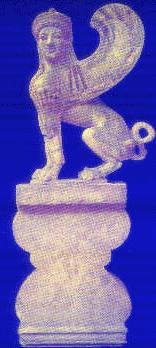
Caption: The Greek Winged Sphinx
However, the kind of causation employed by primitive peoples is of a very special kind. It
is personal causation. That is, the
agent responsible for an action generally has the attributes of human personality.
Impersonal causation, a hallmark of modern science, is regarded as insufficient by
primitive peoples.* Impersonal forces may be the immediate cause of something, but they
are always underlain by ultimate causes, which are usually personal in nature. Thus, the
Kuikuru know it was the wind that blew the roof off a house, but they carry the search for
explanation one step further and ask, "Who sent the wind?" Their implicit
assumption, which they never seem to question, is that some personality, human or spirit,
had to direct the natural force of the wind to produce its effect. How could it be
otherwise? The members of a pre-literate society could not possibly know the physical
causes of cyclonic storms generated high in the atmosphere by complex meteorological
forces.
from an essay, Origin Myths, by Robert L. Carneiro
American Museum of Natural History
Universe Creation
The view that the earth is the center of the
universe, which, until Copernicus, prevailed throughout Europe, was by no means unique to
Western thought. It is no doubt a legacy from Stone Age times. After all, since the earth
is the place where people live and is what they know, and since people create the myths,
why shouldn't they place their planet at the center of the cosmos?
Moreover, if the earth is of prime importance to them - as it is - why not make its
creation primary in time as well? Thus, in
primitive mythology, it is the rule that the world was created first, and that the sun,
the moon, and the stars follow it. In fact, the sun, moon, and stars are often
mythological characters who first lived on earth but who, after a series of adventures or
misfortunes, ended up in the sky to find their ultimate resting place as heavenly bodies.
A few societies have no myth to account for the origin of the world. For them, the world
has always existed. More commonly, however, the earth is thought to have been created by
the actions of supernatural beings. Rarely, though, does a deity create the world out of
nothing: generally, he or she has something to work with. Some Polynesian peoples, for
example, believe that the sea was primeval, and that the land was created by a god, Tane,
who drove to the bottom and came up with mud from which to fashion it.
The Norse gods
Odin, Vill, and Ve made the world from the body of the giant Ymir, using his blood for
oceans, his bones for mountains, his hair for trees, and so on. It is not unusual for
several gods or culture heroes to be involved in the creation, each contributing his or
her portion to the final structure.
Babylonian Creation Myths
From the mixing of Apsu (sweet water) and Tiamat (salt water) there arose the
gods, Mummu (the waves), and
Lakhmu and Lakhamu (gigantic twin serpents). The serpents produced Anshar (heaven) and
Kishar (earth). From these two came Anu, Enlil, and Ea, as well as all the other gods of
the sky, earth, and underworld. Apsu and Tiamat became angered because of the noise made
by such a large group of gods, and began talking about killing off their progeny so they
could get some rest. When Ea, the all-knowing, learned of this he used his magic to
capture Apsu and Mummu. Tiamat was furious and raised a large army of gods and freaks to
battle Ea and his cohorts. Anu and Ea became frightened and Ea created Marduk to battle
Tiamat. Marduk promised to do so if he were granted supremacy over all the other gods. All
the gods agreed and Marduk, armed with bow and arrows, lightning, the winds, a hurricane,
and a special net sallied forth to battle Tiamat. When they clashed, Marduk caught Tiamat
in his special net, and as she opened her mouth to swallow him, loosed the hurricane into
her mouth. As she swelled from the hurricane within her, Marduk slew her with an arrow
into her belly. Then he cast the net again capturing her army within it. These he chained
and cast into the underworld. From her corpse the world is created. He was
th en proclaimed
God of the Gods.
Another Babylonia Creation Myth
In the beginning there was only darkness and water. Out of this Chaos there came
many odd creatures: men with wings, two faces, or both; creatures that were male and
female combined; humans with goat feet; others who were part horse and part man.
These
creatures were ruled over by Omorka, the (female) moon. Marduk cut Omorka in two, and
separated the the halves into sky and earth, and destroyed all of the odd beings that
existed. Then Marduk commanded one of the gods to cut off his head, and from the blood and
clay of the earth, he created humans, animals, stars, sun, moon, and everything that is.
Egyptian Creation Myth
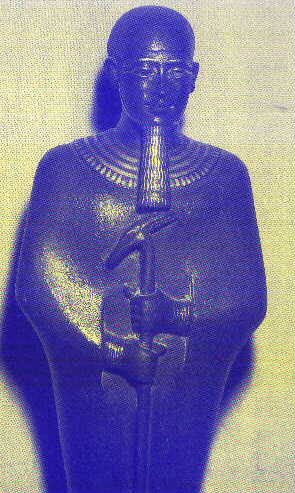
Caption: Creator God, Ptah
Only the ocean existed at first. Then Ra (the sun) came out of an egg that
appeared on the surface of the water. Ra brought forth four children, the gods Shu and Geb
and the goddesses Tefnut and Nut. Shu and Tefnut became the atmosphere.
They stood on Geb,
who became the earth, and raised up Nut, who became the sky. Ra ruled over all. Geb and
Nut later had two sons, Set and Osiris, and two daughters, Isis and Nephthys.
Osiris
succeeded Ra as king of the earth, helped by Isis, his sister-wife. Set, however, hated
his brother and killed him. Isis then embalmed her husband's body with the help of the god
Anubis, who thus became the god of embalming. The powerful charms of Isis resurrected
Osiris, who became king of the netherworld, the land of the dead.
Horus, who was the son
of Osiris and Isis, later defeated Set in a great battle and became king of the earth.
Another Egyptian Creation Myth:
At first there was only Nun, the primal ocean of chaos that contained the
beginnings of everything to come. From these waters came Ra who, by himself, gave birth to
Shu and Tefnut. Shu, the god of air, and Tefnut, the goddess of moisture gave birth to Geb
and Nut, the earth god and the sky goddess. And so the physical universe was created.
Men
were created from Ra's tears. They proved to be ungrateful so Ra, and a council of gods,
decided they should be destroyed. Hathor was dispatched to do the job.
She was very
efficient and slaughtered all but a remnant, when Ra relented and called her off.
Thus was
the present world created. Against Ra's orders, Geb and Nut married.
Ra was incensed and
ordered Shu to separate them, which he did. But Nut was already pregnant, although unable
to give birth as Ra had decreed she could not give birth in any month of any year.
Thoth,
the god of learning, decided to help her and gambling with the moon for extra light, was
able to add five extra days to the 360-day calendar. On those five days Nut gave birth to
Osiris, Horus the Elder, Set, Isis, and Nephthys successively. Osiris became the symbol of
good, while Set became the symbol of evil. And thus the two poles of morality were fixed
once and for all.
One thing to note particularly is that in
every culture for which we have extensive records, there are usually variations of the
creation myth, and sometime outright competitive stories. We can probably assume
that, for the cultures we have less information on, the same phenomenon exists.
For
example, see:
Yoruba
Creation Myth
Vodun (Haitian evolution of Yoruba mythology) Creation Myth
and here we have the evolved remnant of what was
once a very complicated folklore cycle.
Damballah (Sky-serpent loa; wise and loving father) created all the waters of the earth.
The movement of his 7,000
coils, when in his serpent guise, formed hills and valleys on earth and brought forth
stars and planets in the
heavens. He shed his skin in the sunlight, releasing all the waters over the land.
The sun
shone in the water and
created the rainbow. Damballah loved the rainbow's beauty and made her his wife,
Aida-Wedo; she shares his
function as cosmic protector and giver of blessings.
Creation of the Earth

Caption: Animated Graphic from Lars Janssen's
Viking Home Page - Beefy Viking striking a dragon with a Double Axe
Nordic myths tell how the world had been created and how everything was
done. In the beginning there was the abyss
(Ginnungagapet), North of this there was Nifelheim, the world o f cold where Cold and
Darkness rules. Frosty mists rose from the cold well of Hvergelmer. In the south there was
the hot Muspelheim, a place where the being Surte ruled with a flaming sword.
The mists
from Hvergelmer formed the frozen stream of Elivågor which flowed in to the Ginnungagap
and filled it with ice. But at the same time flares from Muspelheim fell into the abyss
and the falling drops which became the result of the mix of flares and ice formed two
giant beings: A cow with the name 'Audhumbla' and a giant named 'Ymer'. Ymer got his food
from the cow by means of four mouths which he used to milk the cows four nipples.
Audhumbla in turn lived on the white frost on the rocks.
Her warm breath created a man called Bure wich by some mysterious way managed to get hold
of a wife (it is not described how) and they where the first of the Asa dynasty of which
Oden, Vile and Ve would be the greatest.
Aztec Creation Myths
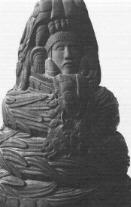
Caption: The Plumed Serpent god
(Aztec mythology) His name means "plumed
serpent". He was the god of vegetation, earth and
water.
One legend says he was the god of creation, who with Tezcatlipoca, pulled the earth
goddess,
Coatlicue, down from the heavens, and in the form of great serpents, they ripped her into
two
pieces to form the earth and sky.
Creation of Man
Beliefs about the origin of human beings fall into three main types: (1)
they have always existed on earth, (2) they did not always exist but were created in some
way, and (3) they previously existed, but in another world, and had somehow to be brought
to this one.
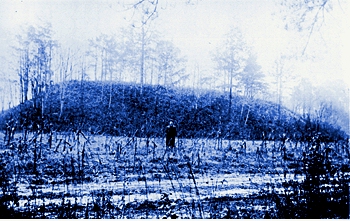
Caption: North American Mounds of Central US
One of the most prevalent origin folktypes is the "emergence"
myth, where the story posits a cave or hole as the source of entry for man. Nanih
Waiya is a flat-topped mound in the style common to most others
constructed in the southeastern U.S. It's base is oblong and covers about an
acre while its peak, which rises 40 feet above the surrounding terrain,
cover one-fourth of an acre. The main mound (also known as the temple
mound) is located on the southeastern edge of a 10 foot high, 1.5 mile
long circular wall and is about 50 yards from Nanih Waiya Creek.
Beyond the creek, by a mile or so, is a second mound called Nanih
Waiya Cave which may be the source of the emergence myth.
Archeological evidence indicates that the site
upon which Nanih Waiya stands had been occupied continuously for approximately 2000 years
before the European invasion. After Contact the site was abandoned. The mound itself was
built between 1500 and 2000 years ago, likely by the Choctaw themselves and the
construction is thought to have taken 2-3 generations to complete and served as the base
for a temple.
See: Choctaw Origin
Myths
A final word here:
Donna Haraway, a new media critic, regards information technology
as potentially liberating precisely because it explodes dangerous myths of origin, and
thus affords some chance of escape from the histories predicated upon those myths:
".... the cyborg has no origin story in the Western sense -- a
'final' irony since the cyborg is also the awful
apocalyptic telos of the 'West's' escalating dominations of abstract individuation, an
ultimate self untied at last from
all dependency, a man in space. An origin story in the 'Western,' humanist sense depends
on the myth of original
unity, fullness, bliss and terror, represented by the phallic mother from whom all humans
must separate, the task of
individual development and of history, the twin potent myths inscribed most powerfully for
us in psychoanalysis
and Marxism. . . . The cyborg skips the step of original unity, of identification with
nature in the Western sense. . . .
The cyborg would not recognize the Garden of Eden; it is not made of mud and cannot dream
of returning to dust."
(Haraway 150-1)
Continue
with Lecture VI.
|







